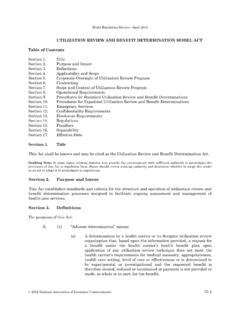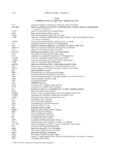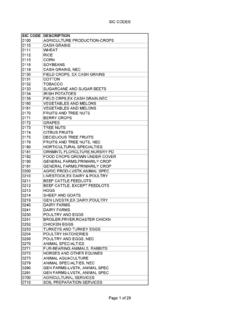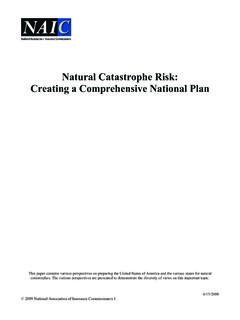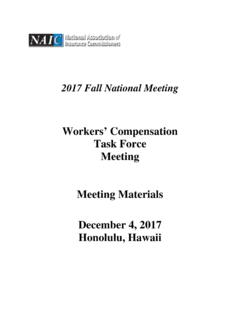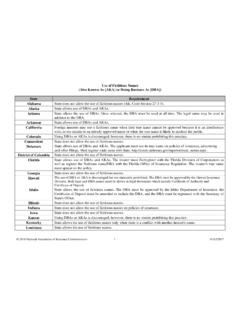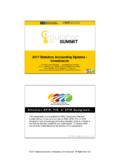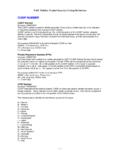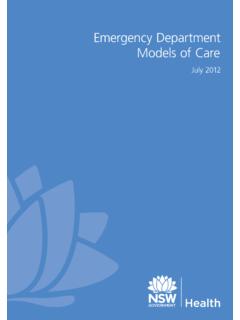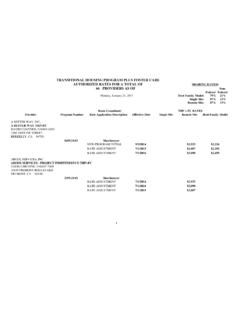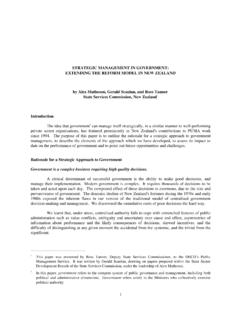Transcription of LONG-TERM CARE INSURANCE MODEL …
1 MODEL Regulation Service 1st Quarter 2017. LONG-TERM care INSURANCE MODEL REGULATION. Table of Contents Section 1. Purpose Section 2. Authority Section 3. Applicability and Scope Section 4. Definitions Section 5. Policy Definitions Section 6. Policy Practices and Provisions Section 7. Unintentional Lapse Section 8. Required Disclosure Provisions Section 9. Required Disclosure of Rating Practices to Consumer Section 10. Initial Filing Requirements Section 11. Prohibition Against Post Claims Underwriting Section 12. Minimum Standards for Home Health and Community care Benefits in LONG-TERM care INSURANCE Policies Section 13. Requirement to Offer Inflation Protection Section 14. Requirements for Application Forms and Replacement Coverage Section 15. Reporting Requirements Section 16. Licensing Section 17. Discretionary Powers of Commissioner Section 18. Reserve Standards Section 19. Loss Ratio Section 20. Premium Rate Schedule Increases Section Premium Rate Schedule Increases for Policies Subject to Loss Ratio Limits Related to Original Filings Section 21.
2 Filing Requirement Section 22. Filing Requirements for Advertising Section 23. Standards for Marketing Section 24. Suitability Section 25. Prohibition Against Preexisting Conditions and Probationary Periods in Replacement Policies or Certificates Section 26. Availability of New Services or Providers Section 27. Right to Reduce Coverage and Lower Premiums Section 28. Nonforfeiture Benefit Requirement Section 29. Standards for Benefit Triggers Section 30. Additional Standards for Benefit Triggers for Qualified LONG-TERM care INSURANCE Contracts Section 31. Appealing an Insurer's Determination that the Benefit Trigger Is Not Met Section 32. Prompt Payment of Clean Claims Section 33. Standard Format Outline of Coverage Section 34. Requirement to Deliver Shopper's Guide Section 35. Penalties Section [ ]. [Optional] Permitted Compensation Arrangements Appendix A. Rescission Reporting Form Appendix B. Personal Worksheet Appendix C. Disclosure Form Appendix D. Response Letter Appendix E. Sample Claims Denial Format 2017 National Association of INSURANCE Commissioners 641-1.
3 LONG-TERM care INSURANCE MODEL Regulation Table of Contents (cont.). Appendix F. Potential Rate Increase Disclosure Form Appendix G. Replacement and Lapse Reporting Form Appendix H. Guidelines for LONG-TERM care Independent Review Entities Section 1. Purpose The purpose of this regulation is to implement [cite section of law which sets forth the NAIC. LONG-TERM care INSURANCE MODEL Act], to promote the public interest, to promote the availability of LONG-TERM care INSURANCE coverage, to protect applicants for LONG-TERM care INSURANCE , as defined, from unfair or deceptive sales or enrollment practices, to facilitate public understanding and comparison of LONG-TERM care INSURANCE coverages, and to facilitate flexibility and innovation in the development of LONG-TERM care INSURANCE . Section 2. Authority This regulation is issued pursuant to the authority vested in the commissioner under [cite sections of law enacting the NAIC LONG-TERM care INSURANCE MODEL Act and establishing the commissioner's authority to issue regulations].
4 Section 3. Applicability and Scope Except as otherwise specifically provided, this regulation applies to all LONG-TERM care INSURANCE policies, including qualified LONG-TERM care contracts and life INSURANCE policies that accelerate benefits for LONG-TERM care delivered or issued for delivery in this state on or after the effective date by insurers; fraternal benefit societies; nonprofit health, hospital and medical service corporations;. prepaid health plans; health maintenance organizations and all similar organizations. Certain provisions of this regulation apply only to qualified LONG-TERM care INSURANCE contracts as noted. Drafting Note: This regulation, like the NAIC LONG-TERM care INSURANCE MODEL Act, is intended to apply to policies, contracts, subscriber agreements, riders and endorsements whether issued by insurers; fraternal benefit societies; nonprofit health, hospital and medical service corporations; prepaid health plans; health maintenance organizations and all similar organizations.
5 In order to include such organizations, regulations should identify them in accordance with statutory terminology or by specific statutory citation. Depending upon state law and regulation, INSURANCE department jurisdiction, and other factors, separate regulations may be required. In any event, the regulation should provide that the particular terminology used by these plans, organizations and arrangements ( , contract, policy, certificate, subscriber, member) may be substituted for, or added to, the corresponding terms used in this regulation. Additionally, this regulation is intended to apply to policies having indemnity benefits that are triggered by activities of daily living and sold as disability income INSURANCE , if: (1) The benefits of the disability income policy are dependent upon or vary in amount based on the receipt of LONG-TERM care services;. (2) The disability income policy is advertised, marketed or offered as INSURANCE for long- term care services; or (3) Benefits under the policy may commence after the policyholder has reached Social Security's normal retirement age unless benefits are designed to replace lost income or pay for specific expenses other than LONG-TERM care services.
6 641-2 2017 National Association of INSURANCE Commissioners MODEL Regulation Service 1st Quarter 2017. Drafting Note: The passage of the Health INSURANCE Portability and Accountability Act of 1996 (HIPAA) created a new category of LONG-TERM care INSURANCE called Qualified LONG-TERM care INSURANCE . This regulation is intended to provide requirements for all LONG-TERM care INSURANCE contracts, including qualified LONG-TERM care INSURANCE contracts, as defined in the NAIC LONG-TERM care INSURANCE MODEL Act and by Section 7702B(b) of the Internal Revenue Code of 1986, as amended. The amendments to this regulation made in recognition of Section 7702B do not require nor prohibit the continued sale of LONG-TERM care INSURANCE policies and certificates that are not considered qualified LONG-TERM care INSURANCE contracts. Section 4. Definitions For the purpose of this regulation, the terms LONG-TERM care INSURANCE , qualified LONG-TERM care INSURANCE , group LONG-TERM care INSURANCE , commissioner, applicant, policy and certificate.
7 Shall have the meanings set forth in Section 4 of the NAIC LONG-TERM care INSURANCE MODEL Act. In addition, the following definitions apply. Drafting Note: Where the word commissioner appears in this regulation, the appropriate designation for the chief INSURANCE supervisory official of the state should be substituted. To the extent that the MODEL act is not adopted, the full definition of the above terms contained in that MODEL act should be incorporated into this section. A. Benefit trigger , for the purposes of independent review, means a contractual provision in the insured's policy of LONG-TERM care INSURANCE conditioning the payment of benefits on a determination of the insured's ability to perform activities of daily living and on cognitive impairment. For purposes of a tax-qualified LONG-TERM care INSURANCE contract, as defined in Section 7702B of the Internal Revenue Code of 1986, as amended, benefit trigger shall include a determination by a licensed health care practitioner that an insured is a chronically ill individual.
8 Drafting Note: This definition is not intended to be a required definitional element of a LONG-TERM care INSURANCE policy, but rather intended to clarify the scope and intent of Section 31. The requirement for a description of the benefit trigger in the policy or certificate is currently found in Section 8. B. (1) Exceptional increase means only those increases filed by an insurer as exceptional for which the commissioner determines the need for the premium rate increase is justified: (a) Due to changes in laws or regulations applicable to LONG-TERM care coverage in this state; or (b) Due to increased and unexpected utilization that affects the majority of insurers of similar products. (2) Except as provided in Sections 20 and , exceptional increases are subject to the same requirements as other premium rate schedule increases. (3) The commissioner may request a review by an independent actuary or a professional actuarial body of the basis for a request that an increase be considered an exceptional increase.
9 (4) The commissioner, in determining that the necessary basis for an exceptional increase exists, shall also determine any potential offsets to higher claims costs. Drafting Note: The commissioner may wish to review the request with other commissioners. 2017 National Association of INSURANCE Commissioners 641-3. LONG-TERM care INSURANCE MODEL Regulation C. Incidental, as used in Sections 20J and , means that the value of the long- term care benefits provided is less than ten percent (10%) of the total value of the benefits provided over the life of the policy. These values shall be measured as of the date of issue. Drafting Note: The phrase value of the benefits is used in defining incidental to make the definition more generally applicable. In simple cases where the base policy and the LONG-TERM care benefits have separately identifiable premiums, the premiums can be directly compared. In other cases, annual cost of INSURANCE charges might be available for comparison. Some cases may involve comparison of present value of benefits.
10 D. Independent review organization means an organization that conducts independent reviews of LONG-TERM care benefit trigger decisions. E. Licensed health care professional means an individual qualified by education and experience in an appropriate field, to determine, by record review, an insured's actual functional or cognitive impairment. Drafting Note: For purposes of Section 31, it may be appropriate for certain licensed health care professionals, such as physical therapists, occupational therapists, neurologists, physical medicine specialists, and rehabilitation medicine specialists, to review a benefit trigger determination. However, some of these health care professionals may not meet the definition of a licensed health care practitioner under Section 7702B(c)(4) of the Internal Revenue Code. For tax-qualified LONG-TERM care INSURANCE contracts, only a licensed health care professional who meets the definition of a licensed health care practitioner may certify that an individual is a chronically ill individual.
